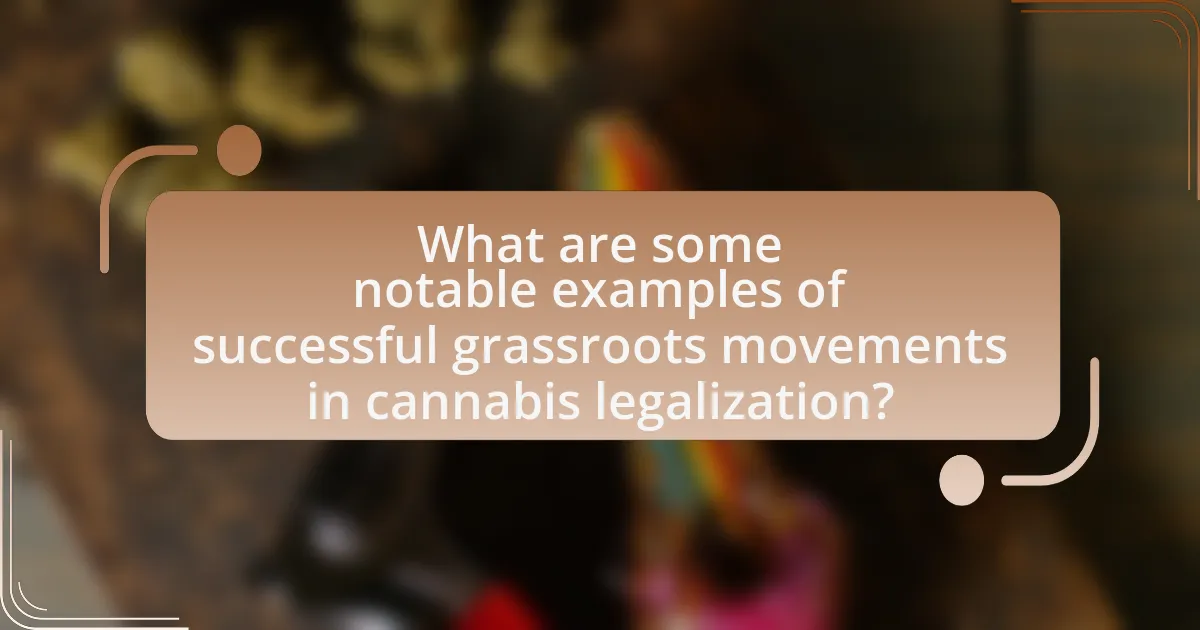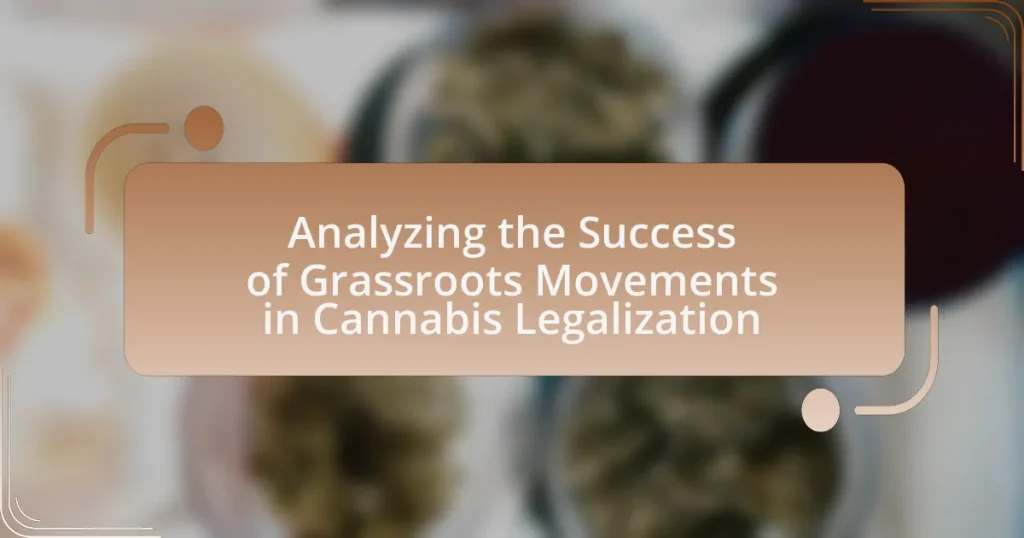Grassroots movements in cannabis legalization are community-driven initiatives aimed at reforming laws and public perceptions surrounding cannabis use. These movements distinguish themselves from traditional advocacy by relying on local activism and direct engagement strategies, such as petitions and social media campaigns. Key characteristics of successful grassroots movements include strong community involvement, clear messaging, and effective organization, which have been instrumental in achieving significant legislative changes in states like California and Colorado. The article analyzes the factors contributing to the success of these movements, their impact on public opinion and policy, and the challenges they face, while highlighting notable examples and best practices for future advocacy efforts.

What are Grassroots Movements in Cannabis Legalization?
Grassroots movements in cannabis legalization are community-driven efforts aimed at changing laws and public perceptions regarding cannabis use and regulation. These movements often emerge from local activists, organizations, and citizens advocating for reform, utilizing strategies such as petitions, public demonstrations, and educational campaigns to mobilize support. Historical examples include the successful legalization initiatives in states like California and Colorado, where grassroots efforts played a crucial role in shaping policy and influencing voter decisions.
How do grassroots movements differ from traditional advocacy efforts?
Grassroots movements differ from traditional advocacy efforts primarily in their structure and approach to mobilization. Grassroots movements are typically community-driven, relying on local individuals to organize and advocate for change, often using social media and direct action to engage a broad base of supporters. In contrast, traditional advocacy efforts are usually led by established organizations or institutions that employ professional lobbyists and formal campaigns to influence policy. For example, the successful legalization of cannabis in various states has often been driven by grassroots initiatives, such as the 2012 Washington Initiative 502, which was largely supported by local activists rather than traditional lobbying groups. This distinction highlights how grassroots movements can leverage community engagement and direct participation to achieve policy changes that may not be prioritized by traditional advocacy methods.
What are the key characteristics of successful grassroots movements?
Successful grassroots movements are characterized by strong community engagement, clear messaging, and effective organization. Community engagement fosters a sense of ownership and mobilizes individuals to participate actively, as seen in the cannabis legalization movements where local advocates rallied support through town hall meetings and social media campaigns. Clear messaging ensures that the goals and values of the movement resonate with a broad audience, exemplified by the use of relatable narratives that highlight personal stories of those affected by cannabis prohibition. Effective organization involves strategic planning and resource allocation, which has been crucial in successful campaigns that have led to legislative changes in various states, such as California’s Proposition 64 in 2016, where a well-structured coalition of activists, businesses, and policymakers worked together to achieve a common goal.
How do grassroots movements mobilize community support?
Grassroots movements mobilize community support by fostering local engagement and building a sense of collective identity among community members. These movements often utilize strategies such as door-to-door canvassing, community meetings, and social media campaigns to raise awareness and encourage participation. For instance, the successful legalization of cannabis in various states has been largely attributed to grassroots organizations that effectively organized rallies, educational events, and lobbying efforts, demonstrating the power of community-driven initiatives. Research indicates that grassroots campaigns can significantly influence public opinion and policy outcomes, as seen in the 2012 Colorado and Washington cannabis legalization votes, where local advocacy played a crucial role in shaping voter attitudes and mobilizing turnout.
Why are grassroots movements important for cannabis legalization?
Grassroots movements are crucial for cannabis legalization because they mobilize community support and influence public opinion. These movements often consist of local activists who advocate for policy changes, educate the public about the benefits of cannabis, and challenge existing stigmas. For instance, the successful legalization efforts in states like Colorado and California were largely driven by grassroots organizations that gathered signatures for ballot initiatives, demonstrating the power of collective action. Research indicates that grassroots campaigns can significantly impact legislative outcomes, as seen in the 2012 Colorado Amendment 64 campaign, which achieved over 55% voter approval, showcasing how organized community efforts can lead to substantial legal reforms.
What role do grassroots movements play in shaping public opinion?
Grassroots movements play a crucial role in shaping public opinion by mobilizing community engagement and fostering dialogue around specific issues. These movements often utilize social media, local events, and direct outreach to raise awareness and educate the public, effectively influencing perceptions and attitudes. For instance, the cannabis legalization movement has seen significant shifts in public opinion, with a Gallup poll indicating that support for legalization rose from 25% in 1995 to 68% in 2021, largely driven by grassroots advocacy efforts. Such movements create a platform for marginalized voices, enabling them to advocate for policy changes that reflect community values and needs, thereby directly impacting legislative outcomes and societal norms.
How do grassroots movements influence policy changes?
Grassroots movements influence policy changes by mobilizing community support and advocating for specific legislative reforms. These movements often utilize strategies such as organizing protests, engaging in public education campaigns, and leveraging social media to raise awareness and build coalitions. For example, the cannabis legalization movement in the United States has seen significant success due to grassroots efforts, which have led to the passage of laws in multiple states. According to a report by the National Organization for the Reform of Marijuana Laws (NORML), grassroots campaigns played a crucial role in the legalization of cannabis in states like Colorado and California, where public support surged due to sustained advocacy and community engagement.

What factors contribute to the success of grassroots movements in cannabis legalization?
Grassroots movements in cannabis legalization succeed due to effective community engagement, strategic coalition-building, and the ability to leverage public opinion. Community engagement fosters local support, as seen in states like Colorado, where grassroots efforts mobilized citizens to advocate for legalization through petitions and local events. Strategic coalition-building, involving partnerships with various stakeholders such as health organizations and civil rights groups, enhances credibility and broadens the movement’s reach. Additionally, leveraging public opinion is critical; for instance, polls indicating increasing public support for cannabis legalization have influenced legislative decisions, as demonstrated in California’s 2016 Proposition 64, which passed with significant voter backing. These factors collectively create a robust framework for the success of grassroots movements in cannabis legalization.
How does community engagement impact the effectiveness of these movements?
Community engagement significantly enhances the effectiveness of grassroots movements in cannabis legalization by fostering a sense of ownership and collective action among participants. When community members actively participate, they contribute to a shared vision, which increases motivation and mobilization efforts. For instance, research by the Drug Policy Alliance indicates that grassroots campaigns with high community involvement are more likely to achieve legislative success, as seen in states like Colorado and Washington, where local advocacy groups played crucial roles in shaping public opinion and policy. This engagement not only amplifies voices but also builds networks that can effectively challenge opposition, demonstrating that community-driven initiatives are vital for advancing cannabis legalization efforts.
What strategies do successful grassroots movements employ to engage the community?
Successful grassroots movements engage the community through strategies such as building local coalitions, utilizing social media for outreach, and organizing community events. Building local coalitions allows movements to unite diverse groups, enhancing their collective voice and influence. For instance, the Cannabis Freedom Alliance in the United States successfully mobilized various stakeholders, including patients, advocates, and businesses, to advocate for cannabis legalization. Utilizing social media platforms enables grassroots movements to disseminate information rapidly and engage with a broader audience, as seen in the #YesOnProp64 campaign in California, which effectively used social media to inform and rally support. Organizing community events fosters direct interaction, allowing individuals to share personal stories and experiences, which can humanize the cause and strengthen community ties, exemplified by local cannabis fairs that educate the public and promote advocacy. These strategies collectively enhance community involvement and support for grassroots movements.
How does the use of social media enhance grassroots efforts?
The use of social media enhances grassroots efforts by facilitating rapid communication and mobilization among supporters. Social media platforms allow grassroots organizations to disseminate information quickly, engage with a wider audience, and organize events effectively. For instance, during the cannabis legalization movements, platforms like Facebook and Twitter have been instrumental in rallying supporters, sharing success stories, and coordinating protests or lobbying efforts. Research indicates that social media campaigns can significantly increase public awareness and support, as seen in the 2012 legalization efforts in Colorado, where social media played a crucial role in shaping public opinion and driving voter turnout.
What challenges do grassroots movements face in cannabis legalization?
Grassroots movements face significant challenges in cannabis legalization, primarily due to limited funding and resources. These movements often rely on small donations and volunteer efforts, which restrict their ability to compete against well-funded opposition groups and lobbyists. Additionally, they encounter legal hurdles, as existing laws and regulations can be complex and vary widely by jurisdiction, complicating advocacy efforts. Public perception also poses a challenge; misinformation and stigma surrounding cannabis can hinder support for legalization initiatives. For instance, a 2021 survey by the Pew Research Center indicated that while support for legalization has increased, a substantial portion of the population still holds negative views about cannabis use. These factors collectively impede the effectiveness and reach of grassroots movements in their pursuit of cannabis legalization.
How do legal and political obstacles affect grassroots initiatives?
Legal and political obstacles significantly hinder grassroots initiatives by limiting their ability to mobilize support and implement change. For instance, restrictive laws can prevent grassroots organizations from gathering signatures for petitions or conducting public outreach, thereby stifling their efforts to influence policy. Additionally, political opposition can lead to unfavorable legislation that undermines the goals of these initiatives, as seen in various states where cannabis legalization efforts faced pushback from lawmakers. Research indicates that in states with stringent regulatory frameworks, grassroots movements often struggle to gain traction, resulting in lower success rates for legalization efforts.
What strategies can grassroots movements use to overcome these challenges?
Grassroots movements can overcome challenges by employing strategies such as building coalitions, leveraging social media, and engaging in community education. Building coalitions with other organizations enhances resource sharing and amplifies voices, as seen in the collaboration between the National Organization for the Reform of Marijuana Laws (NORML) and local advocacy groups, which has strengthened campaigns across various states. Leveraging social media allows grassroots movements to reach wider audiences quickly and effectively; for instance, campaigns like #LegalizeIt have mobilized support and raised awareness rapidly. Engaging in community education fosters informed advocacy, as demonstrated by initiatives that provide factual information about cannabis benefits and legal implications, which can shift public perception and influence policymakers. These strategies collectively empower grassroots movements to navigate obstacles and drive successful cannabis legalization efforts.

What are some notable examples of successful grassroots movements in cannabis legalization?
Notable examples of successful grassroots movements in cannabis legalization include the 2012 campaign in Colorado and Washington, which led to the legalization of recreational cannabis through voter initiatives. These movements were driven by organizations like the Campaign to Regulate Marijuana Like Alcohol in Colorado and New Approach Washington, which mobilized citizens, gathered signatures, and educated the public on the benefits of legalization. The success of these initiatives is evidenced by Colorado generating over $1 billion in cannabis tax revenue since legalization and Washington seeing similar economic benefits, demonstrating the effectiveness of grassroots advocacy in changing cannabis laws.
How did specific grassroots movements achieve their goals?
Specific grassroots movements achieved their goals through strategic organization, community engagement, and effective lobbying. For instance, the legalization of cannabis in states like Colorado and Washington was driven by grassroots campaigns that mobilized local communities to advocate for policy changes. These movements utilized petitions to gather public support, organized rallies to raise awareness, and engaged in direct dialogue with lawmakers to influence legislation. In Colorado, the campaign “Safer Alternative for Enjoyable Recreation” successfully gathered over 100,000 signatures to place legalization on the ballot, demonstrating the power of grassroots mobilization. Additionally, the use of social media platforms allowed these movements to reach a broader audience, fostering a sense of community and urgency around the issue. The combination of these tactics not only raised public awareness but also created a political environment conducive to change, ultimately leading to the successful legalization of cannabis in multiple states.
What lessons can be learned from the successes of these movements?
The successes of grassroots movements in cannabis legalization demonstrate the importance of community engagement and strategic messaging. These movements effectively mobilized local support, which was crucial in influencing public opinion and policy changes. For instance, the 2012 legalization of recreational cannabis in Colorado was significantly driven by grassroots campaigns that educated voters on the benefits of legalization, resulting in a 55% approval rate. Additionally, the use of social media platforms allowed these movements to reach a broader audience, facilitating rapid information dissemination and community organization. This highlights that leveraging technology and grassroots advocacy can lead to substantial legislative victories.
How did collaboration with other organizations enhance their efforts?
Collaboration with other organizations significantly enhanced grassroots movements in cannabis legalization by pooling resources, expertise, and networks. This collective effort allowed for more effective advocacy campaigns, as seen in the successful passage of legalization measures in various states, where coalitions of local advocacy groups, legal experts, and medical professionals worked together. For instance, the collaboration between organizations like the Drug Policy Alliance and local grassroots groups in California led to the successful Proposition 64 campaign in 2016, which legalized recreational cannabis use. Such partnerships not only amplified their voices but also provided a broader platform for education and outreach, ultimately increasing public support and legislative success.
What impact have these movements had on cannabis legislation?
Grassroots movements have significantly influenced cannabis legislation by mobilizing public support and advocating for policy changes. These movements have led to the legalization of cannabis in numerous states across the United States, with over 20 states legalizing recreational use as of 2023. For instance, the successful campaign in California in 1996 for Proposition 215 marked the first state to legalize medical cannabis, setting a precedent that inspired similar initiatives nationwide. Additionally, organizations like the Marijuana Policy Project have played crucial roles in lobbying for legislative reforms, contributing to shifts in public perception and policy. This grassroots activism has been instrumental in shaping a more favorable legal landscape for cannabis, demonstrating the power of collective action in influencing legislative outcomes.
How have successful grassroots movements changed public perception of cannabis?
Successful grassroots movements have significantly shifted public perception of cannabis from a stigmatized substance to one viewed as a legitimate option for medical and recreational use. Campaigns such as the legalization efforts in states like Colorado and Washington, which began in the early 2010s, mobilized community support and educated the public on the benefits and safety of cannabis, leading to increased acceptance. According to a 2021 Gallup poll, 68% of Americans now support legalizing cannabis, a marked increase from just 25% in 1995, illustrating the effectiveness of these movements in changing societal attitudes.
What long-term effects have these movements had on cannabis policy?
Grassroots movements have significantly influenced long-term cannabis policy by driving legalization efforts across various jurisdictions. These movements have led to the decriminalization of cannabis in numerous states, with over 20 states in the U.S. legalizing recreational use as of 2023. Additionally, public opinion has shifted dramatically, with a Gallup poll indicating that 68% of Americans support legalization, reflecting the impact of advocacy and education campaigns. Furthermore, these movements have prompted legislative changes that include the establishment of regulatory frameworks for cannabis sales, taxation, and public health considerations, thereby shaping a more structured approach to cannabis policy.
What best practices can grassroots movements adopt for future success in cannabis legalization?
Grassroots movements can adopt several best practices for future success in cannabis legalization, including building broad coalitions, utilizing data-driven advocacy, and engaging in effective communication strategies. Building broad coalitions allows movements to unite diverse stakeholders, increasing political influence and public support; for instance, the coalition-building efforts in California led to the successful passage of Proposition 64 in 2016. Utilizing data-driven advocacy involves leveraging research and statistics to inform policy proposals and counter opposition arguments, as seen in the successful campaigns in states like Colorado, where economic data highlighted the benefits of legalization. Engaging in effective communication strategies, such as social media outreach and storytelling, can help personalize the issue and mobilize grassroots support, which was crucial in the campaigns that led to legalization in states like Oregon. These practices collectively enhance the effectiveness and reach of grassroots movements in the cannabis legalization landscape.
How can grassroots movements effectively measure their impact?
Grassroots movements can effectively measure their impact by utilizing a combination of quantitative and qualitative metrics. Quantitative metrics include tracking changes in public opinion through surveys, monitoring legislative outcomes such as the number of bills passed or policies enacted, and analyzing participation rates in events or campaigns. For example, a study by the Pew Research Center found that public support for cannabis legalization increased from 32% in 2010 to 60% in 2019, indicating the effectiveness of grassroots advocacy in shifting public perception.
Qualitative metrics involve gathering testimonials, case studies, and narratives that illustrate the personal stories behind the movement’s efforts. This can include documenting individual experiences of those affected by cannabis laws, which can provide compelling evidence of the movement’s social impact. Research published in the Journal of Drug Policy Analysis highlights how personal stories can influence policymakers and public opinion, thereby reinforcing the movement’s objectives.
By combining these approaches, grassroots movements can create a comprehensive picture of their impact, demonstrating both statistical changes and personal narratives that resonate with broader audiences.
What role does continuous community involvement play in sustaining momentum?
Continuous community involvement is crucial for sustaining momentum in grassroots movements, particularly in cannabis legalization efforts. This ongoing engagement fosters a sense of ownership and commitment among community members, which is essential for maintaining enthusiasm and participation over time. Research indicates that movements with active community involvement are more likely to achieve long-term success, as seen in the cannabis legalization campaigns in states like Colorado and California, where local advocacy groups mobilized citizens through consistent outreach and education. These efforts not only keep the community informed but also empower individuals to advocate for policy changes, thereby reinforcing the movement’s momentum.


